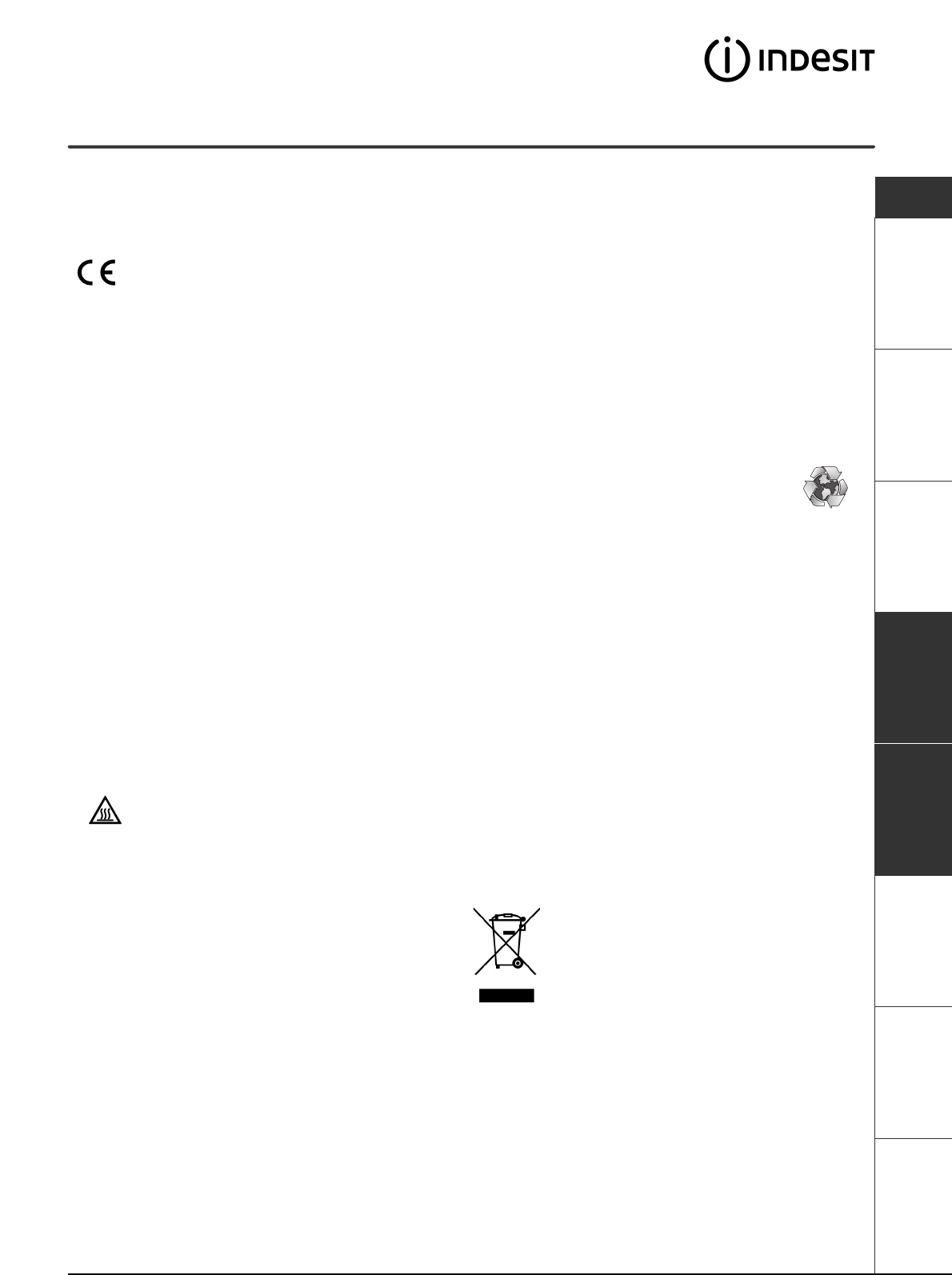
9
Installation
Description
Start and
Programmes
Laundry
Warnings and
Suggestions
Maintenance and
Care Troubleshooting Service
GB
Warnings and Suggestions
! The appliance has been designed and built
according to international safety standards.
These warnings are given for safety reasons and
must be read carefully.
This appliance conforms to the following
EEC Directives:
- 72/23/EEC and 93/68/EEC (Low Voltage Equipment)
- 89/336/EEC, 92/31/EEC and 93/68/EEC
(Electromagnetic Compatibility)
General safety
●
This tumble dryer has been designed for home,
and not professional use.
●
This dryer must be used by adults, and the
instructions in this booklet should be followed carefully.
●
Do not touch the appliance while barefoot or with
wet hands or feet.
●
Unplug the machine by pulling on the plug, not
the cord.
●
Children must not be in proximity of the dryer
when in use. After using the dryer, turn it off and
unplug it. Keep the door closed to make sure that
children do not use it as a toy.
●
The appliance must be installed correctly and
have proper ventilation. The air intake at the front
of the dryer and rear vent behind the dryer should
never be obstructed (see Installation).
●
Never use the dryer on carpeting where the pile
height would prevent air from entering the dryer
from the base.
●
Check to see if the dryer is empty before loading it.
●
The back of the dryer could become very
hot. Never touch it while in use.
●
Do not use the dryer unless the filter, water
container and condenser are securely in place
(see Maintenance).
●
Do not use liquid fabric softeners in the dryer, add
it to the final rinse of your wash.
●
Do not overload the dryer (see Laundry for
maximum loads).
●
Do not load items that are dripping wet.
●
Tumble dry items only if they have been washed
with detergent and water, rinsed and been through
the spin cycle. It is a fire hazard to dry items that
HAVE NOT been washed with water.
●
Carefully check all instructions on clothing labels
(see Laundry).
●
Do not dry garments that have been treated with
chemical products.
●
Never dry articles that are contaminated with
flammable substances (petrol, oil, paint, hair
spray, creams, cooking fat or oils).
●
Do not tumble dry rubber, foam rubber, plastic, plastic
foam, nappy pants or liners, polythene or paper.
●
Do not tumble dry large, very bulky items.
●
Do not tumble dry acrylic fibres at high temperatures.
●
Complete each programme with its Cool Tumble Phase.
●
Do not turn off the dryer when there are still warm
items inside.
●
Clean the filter after each use (see Maintenance).
●
Empty the water container after each use (see
Maintenance).
●
Clean the condenser unit after regular intervals
(see Maintenance).
●
Do not allow lint to collect around the dryer.
●
Never climb on top of the dryer. It could result in damage.
●
Always follow electrical standards and requirements
(see Installation).
●
Always buy original spare parts and accessories
(see Service).
Recycling and disposal information
As part of our continued commitment to helping the
environment, we reserve the right to use quality recycled
components to keep down customer costs and minimise
material wastage.
●
Disposing of the packaging material: follow local
regulations, so the packaging can be recycled.
●
To minimise risk of injury to children, remove the
door and plug - then cut off mains cable, flush
with the appliance. Dispose of these parts separately
to ensure that the appliance can no longer be
plugged into a mains socket.
Disposal of old electrical appliances
The European Directive 2002/96/EC on Waste Electrical
and Electronic Equipment (WEEE), requires that old
household electrical appliances must not be disposed
of in the normal unsorted municipal waste stream.
Old appliances must be collected separately in order
to optimise the recovery and recycling of the materials
they contain and reduce the impact on human health
and the environment.
The crossed out “wheeled bin” symbol on
the product reminds you of your obligation,
that when you dispose of the appliance it
must be separately collected.
Consumers should contact their local authority or
retailer for information concerning the correct disposal
of their old appliance.
Saving energy and respecting the
environment
●
Wring out items to eliminate excess water before
tumble drying (if you use a washing machine first,
select a high spin cycle). Doing this will save time
and energy during drying.
●
Always dry full loads - you save energy: single
items or small loads take longer to dry.
●
Clean the filter after each use to contain energy
consumption costs (see Maintenance).


















